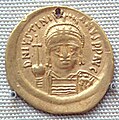
Indo-Roman trade relations
Indo-Roman trade relations (see also the spice trade and incense road) was trade between the Indian subcontinent and the Roman Empire in Europe and the Mediterranean Sea. Trade through the overland caravan routes via Asia Minor and the Middle East, though at a relative trickle compared to later times, preceded the southern trade route via the Red Sea which started around the beginning of the Common Era (CE) following the reign of Augustus and his conquest of Egypt in 30 BCE.[1]
The southern route so helped enhance trade between the ancient Roman Empire and the Indian subcontinent, that Roman politicians and historians are on record decrying the loss of silver and gold to buy silk to pamper Roman wives, and the southern route grew to eclipse and then totally supplant the overland trade route.[2] Roman and Greek traders frequented the ancient Tamil country, present day Southern India and Sri Lanka, securing trade with the seafaring Tamil states of the Pandyan, Chola and Chera dynasties and establishing trading settlements which secured trade with the Indian subcontinent by the Greco-Roman world since the time of the Ptolemaic dynasty[3] a few decades before the start of the Common Era and remained long after the fall of the Western Roman Empire.[4]
The replacement of Greek kingdoms by the Roman Empire as the administrator of the eastern Mediterranean basin led to the strengthening of direct maritime trade with the east and the elimination of the taxes extracted previously by the middlemen of various land based trading routes.[10] Strabo's mention of the vast increase in trade following the Roman annexation of Egypt indicates that monsoon was known from his time.[11]
The trade started by Eudoxus of Cyzicus in 130 BCE kept increasing according to Strabo (II.5.12.):[12]
By the time of Augustus up to 120 ships were setting sail every year from Myos Hormos to India.[12] So much gold was used for this trade, and apparently recycled by the Kushan Empire (Kushans) for their own coinage, that Pliny the Elder (NH VI.101) complained about the drain of specie to India:

